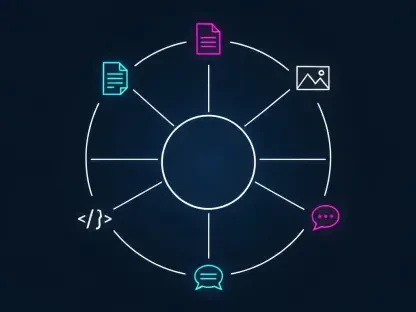Oscar Vail’s expertise in technology and robotics is renowned, having navigated the evolving landscape of quantum computing and open-source initiatives. His recent endeavor at a Canberra innovation festival, involving the integration of Large Language Models (LLM) capabilities, like ChatGPT, into humanoid robots, drew both intrigue and critical observation from attendees. With the Pepper robot at the forefront of this experiment, the interactions revealed the complex interplay between advanced technology and human participants, highlighting insights and areas for growth. This interview delves into the motivations and anticipations behind this project and the feedback received from those who engaged with Pepper.
Can you elaborate on the inspiration behind integrating LLM capabilities like ChatGPT into the Pepper robot?
The inspiration stemmed from the rapid advancements in LLM technology. We wanted to explore how these models could enhance the natural interaction abilities of humanoid robots, leveraging the capabilities of ChatGPT to create more engaging and responsive experiences. Pepper’s existing strengths in navigation and eye contact made it ideal for testing these emerging interaction dynamics.
What were the key objectives you aimed to achieve with this experiment at the innovation festival?
We were primarily focused on understanding how people react to and engage with a humanoid robot enhanced by LLM capabilities. Our goal was to assess if such a setup could provide meaningful interactions and identify what improvements might be necessary for future iterations.
How did the functionality of Pepper evolve with the addition of LLM capabilities compared to its previous version?
Previously, Pepper was adept at basic interactions and autonomous movements. By integrating LLM capabilities, it could handle more complex dialogues and personalize engagement based on user input, allowing it to simulate more natural conversations, albeit with varying success, as feedback indicated.
What specific LLM features were integrated into Pepper, and why were they chosen?
Features like nuanced language understanding and adaptive responses were integrated to enhance Pepper’s conversational skills. These were chosen with the intention to mimic human-like comprehension and dialogue, aiming for interactions that felt authentic and immersive.
What kinds of interactions were festival-goers encouraged to engage in with Pepper?
Participants were encouraged to engage in casual conversations, ask questions, and even test the limits of Pepper’s responses. We wanted them to feel comfortable probing its abilities, which would provide us with rich data on its strengths and limitations.
How did the team monitor and record these interactions for analysis?
We employed a dual approach: real-time observation and post-interaction surveys. Each interaction was carefully logged, and participants were asked for detailed feedback, allowing us to analyze behavioral trends and emotional responses comprehensively.
Could you share some examples of positive reactions from the participants?
Some participants praised Pepper’s ability to keep eye contact and its surprisingly coherent responses. The novelty and potential of engaging with an advanced humanoid left several intrigued and optimistic about future developments.
What were some examples of negative feedback or criticisms provided by the attendees?
The most frequent criticisms involved Pepper’s occasional delay in response and its inability to recognize facial expressions, which some felt was incongruent with its advanced design. These revealed areas where improvements are necessary.
How did you categorize the feedback into themes like ideas for improvement and emotional responses?
We parsed feedback using qualitative analysis techniques, grouping comments by narrative consistency and recurring themes. This allowed us to categorize inputs into practical improvements, whether technical glitches or suggestions related to the robot’s design.
Could you describe some of the preconceptions participants had going into the interaction?
Many expected Pepper to exhibit human-like empathy and seamless responses, perhaps influenced by sci-fi portrayals of humanoid robots. These preconceptions highlighted the gap between current robotic capabilities and idealized expectations.
What types of glitches or issues did Pepper encounter during its interactions, and how do you plan to address them?
Pepper sometimes took longer to process and respond to inputs, leading to awkward silences. There were challenges in synchronizing its verbal responses with eye contact. We plan to upgrade the processing algorithms to reduce latency and enhance responsiveness.
How did the participants’ expectations compare to their actual experiences with Pepper?
Expectations leaned towards highly interactive experiences, akin to those depicted in media, which were only partially met. The discrepancy underscored the need to manage expectations and transparently communicate technological limitations.
In what ways did participants suggest improving the robot’s design or capabilities?
Suggestions included faster processing times, improved facial recognition, and enhanced emotion detection capabilities. These inputs will guide the next iteration of design enhancements and capability expansion.
How important is eye contact for humanoid robots, and what challenges does it present in terms of human-like interactions?
Eye contact is crucial as it builds engagement and trust. However, mimicking the subtleties of human eye movements and gaze, particularly in complex scenarios, poses technical challenges, requiring advanced calibration and software enhancements.
How can Pepper be adapted to better recognize and respond to human facial expressions in the future?
We’ll explore integrating machine learning models focused on facial recognition and emotional analysis. By improving sensory inputs and processing capabilities, Pepper can better interpret and react to human emotions and expressions.
Were there any surprising findings or reactions during the study that you did not anticipate?
We didn’t anticipate the strong sense of discomfort some felt with Pepper’s prolonged eye contact. This highlighted a nuanced aspect of human-robot interaction that we’ll need to address, fostering more natural engagement.
How do you plan to use the feedback collected to enhance Pepper’s future iterations?
The feedback is invaluable for refining Pepper’s conversational abilities, responsiveness, and how it can better simulate human interaction dynamics. We’re prioritizing these areas for development to overcome the highlighted issues and enhance overall user experience.
What is your vision for the future of humanoid robots with integrated LLM capabilities?
I envision humanoid robots as versatile companions that can offer personalized, context-aware interactions. With advancements in LLM technology, they can become more intuitive, understanding, and empathetic, bridging the gap between robotic and human engagement.
Do you believe that technological advancements in LLMs will eventually rival human social interaction skills? Why or why not?
While LLMs will continue to evolve and improve, human social interactions involve complexities and subtleties that may remain challenging for machines to completely emulate. Technology will progress greatly, but I think human social skills will maintain unique nuances beyond pure computational replicability.









